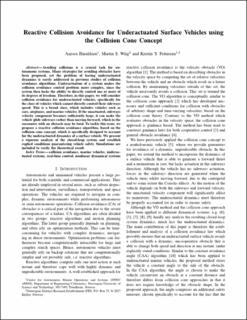Reactive Collision Avoidance for Underactuated Surface Vehicles using the Collision Cone Concept
Chapter
Accepted version

Åpne
Permanent lenke
https://hdl.handle.net/11250/2926587Utgivelsesdato
2021Metadata
Vis full innførselSamlinger
Originalversjon
https://doi.org/10.1109/CCTA48906.2021.9659043Sammendrag
Avoiding collisions is a crucial task for autonomous systems. Many strategies for avoiding obstacles have been proposed, yet the problem of having underactuated dynamics is rarely addressed in previous studies of collision avoidance algorithms. Underactuation of a system makes the collision avoidance control problem more complex, since the system then lacks the ability to directly control one or more of its degrees of freedom. Therefore, in this paper, we will consider collision avoidance for underactuated vehicles, specifically for the class of vehicles which cannot directly control their sideways speed. This is a broad class, which includes vehicles such as cars, airplanes, and marine vehicles. If the unactuated, sideways velocity component becomes sufficiently large, it can make the vehicle glide sideways rather than moving forward, which in the encounter with an obstacle may be fatal. To tackle this issue, we propose a reactive collision avoidance algorithm, based on the collision cone concept, which is specifically designed to account for the underactuated dynamics of a surface vehicle. We present a rigorous analysis of the closed-loop system and establish explicit conditions guaranteeing vehicle safety. Simulations are included to verify the theoretical result.